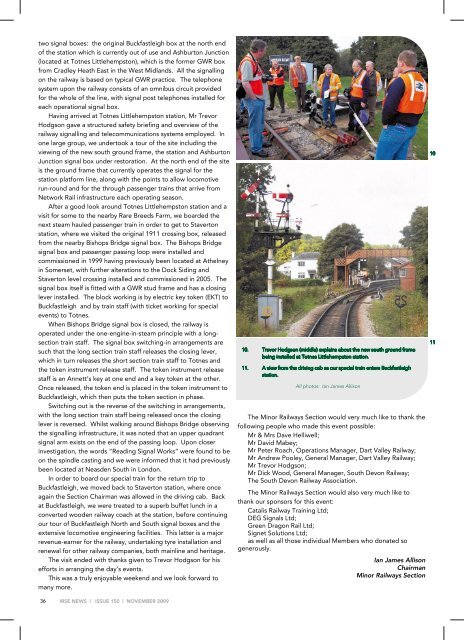IRSE News 150 Nov 09.pdf
IRSE News 150 Nov 09.pdf
IRSE News 150 Nov 09.pdf
You also want an ePaper? Increase the reach of your titles
YUMPU automatically turns print PDFs into web optimized ePapers that Google loves.
two signal boxes: the original Buckfastleigh box at the north end<br />
of the station which is currently out of use and Ashburton Junction<br />
(located at Totnes Littlehempston), which is the former GWR box<br />
from Cradley Heath East in the West Midlands. All the signalling<br />
on the railway is based on typical GWR practice. The telephone<br />
system upon the railway consists of an omnibus circuit provided<br />
for the whole of the line, with signal post telephones installed for<br />
each operational signal box.<br />
Having arrived at Totnes Littlehempston station, Mr Trevor<br />
Hodgson gave a structured safety briefing and overview of the<br />
railway signalling and telecommunications systems employed. In<br />
one large group, we undertook a tour of the site including the<br />
viewing of the new south ground frame, the station and Ashburton<br />
Junction signal box under restoration. At the north end of the site<br />
is the ground frame that currently operates the signal for the<br />
station platform line, along with the points to allow locomotive<br />
run-round and for the through passenger trains that arrive from<br />
Network Rail infrastructure each operating season.<br />
After a good look around Totnes Littlehempston station and a<br />
visit for some to the nearby Rare Breeds Farm, we boarded the<br />
next steam hauled passenger train in order to get to Staverton<br />
station, where we visited the original 1911 crossing box, released<br />
from the nearby Bishops Bridge signal box. The Bishops Bridge<br />
signal box and passenger passing loop were installed and<br />
commissioned in 1999 having previously been located at Athelney<br />
in Somerset, with further alterations to the Dock Siding and<br />
Staverton level crossing installed and commissioned in 2005. The<br />
signal box itself is fitted with a GWR stud frame and has a closing<br />
lever installed. The block working is by electric key token (EKT) to<br />
Buckfastleigh and by train staff (with ticket working for special<br />
events) to Totnes.<br />
When Bishops Bridge signal box is closed, the railway is<br />
operated under the one-engine-in-steam principle with a longsection<br />
train staff. The signal box switching-in arrangements are<br />
such that the long section train staff releases the closing lever,<br />
which in turn releases the short section train staff to Totnes and<br />
the token instrument release staff. The token instrument release<br />
staff is an Annett’s key at one end and a key token at the other.<br />
Once released, the token end is placed in the token instrument to<br />
Buckfastleigh, which then puts the token section in phase.<br />
Switching out is the reverse of the switching in arrangements,<br />
with the long section train staff being released once the closing<br />
lever is reversed. Whilst walking around Bishops Bridge observing<br />
the signalling infrastructure, it was noted that an upper quadrant<br />
signal arm exists on the end of the passing loop. Upon closer<br />
investigation, the words “Reading Signal Works” were found to be<br />
on the spindle casting and we were informed that it had previously<br />
been located at Neasden South in London.<br />
In order to board our special train for the return trip to<br />
Buckfastleigh, we moved back to Staverton station, where once<br />
again the Section Chairman was allowed in the driving cab. Back<br />
at Buckfastleigh, we were treated to a superb buffet lunch in a<br />
converted wooden railway coach at the station, before continuing<br />
our tour of Buckfastleigh North and South signal boxes and the<br />
extensive locomotive engineering facilities. This latter is a major<br />
revenue-earner for the railway, undertaking tyre installation and<br />
renewal for other railway companies, both mainline and heritage.<br />
The visit ended with thanks given to Trevor Hodgson for his<br />
efforts in arranging the day’s events.<br />
This was a truly enjoyable weekend and we look forward to<br />
many more.<br />
10. Trevor Hodgson (middle) explains about the new south ground frame<br />
being installed at Totnes Littlehempston station.<br />
11. A view from the driving cab as our special train enters Buckfastleigh<br />
station.<br />
All photos: Ian James Allison<br />
The Minor Railways Section would very much like to thank the<br />
following people who made this event possible:<br />
Mr & Mrs Dave Helliwell;<br />
Mr David Mabey;<br />
Mr Peter Roach, Operations Manager, Dart Valley Railway;<br />
Mr Andrew Pooley, General Manager, Dart Valley Railway;<br />
Mr Trevor Hodgson;<br />
Mr Dick Wood, General Manager, South Devon Railway;<br />
The South Devon Railway Association.<br />
The Minor Railways Section would also very much like to<br />
thank our sponsors for this event:<br />
Catalis Railway Training Ltd;<br />
DEG Signals Ltd;<br />
Green Dragon Rail Ltd;<br />
Signet Solutions Ltd;<br />
as well as all those individual Members who donated so<br />
generously.<br />
Ian James Allison<br />
Chairman<br />
Minor Railways Section<br />
10<br />
11<br />
36<br />
<strong>IRSE</strong> NEWS | ISSUE <strong>150</strong> | NOVEMBER 2009

















